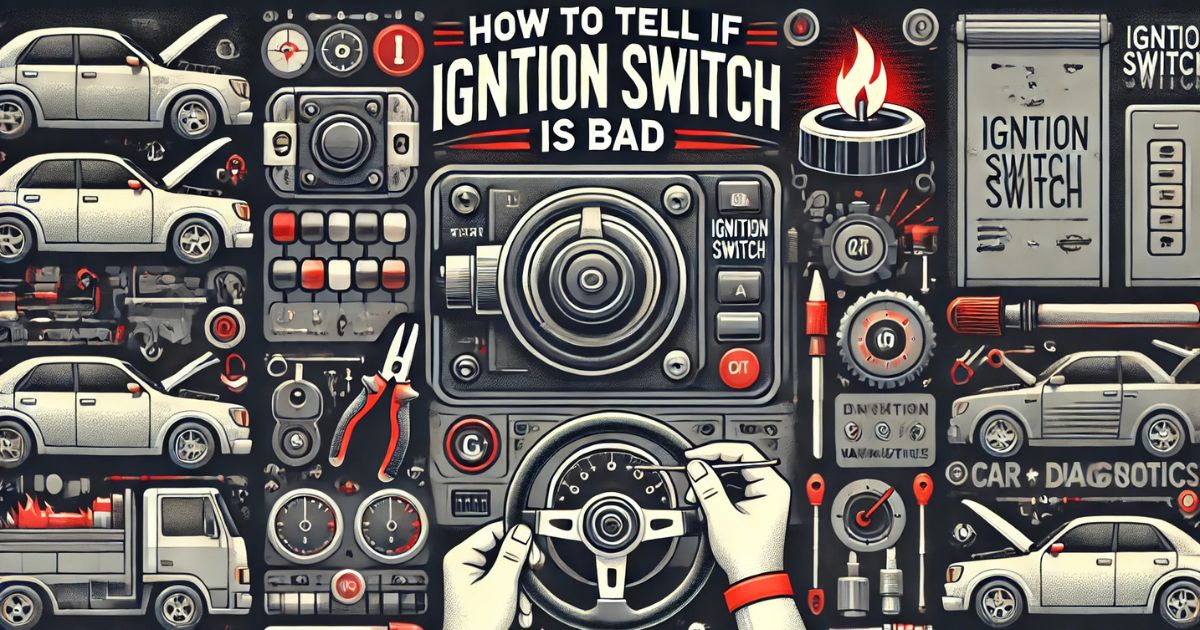Introduction
The ignition switch is a critical component in your vehicle’s electrical and starting systems. It activates the power to your car’s electronics and engine, allowing you to start and operate your vehicle. When the ignition switch begins to fail, it can cause a wide range of frustrating and potentially dangerous symptoms. In this comprehensive guide, we’ll explain how to tell if ignition switch is bad, covering warning signs, testing methods, common causes, and what to do if you need a replacement.
What Is an Ignition Switch?
The ignition switch is typically located behind the ignition lock cylinder—the place where you insert your key. In push-button start vehicles, the switch is connected to the start button. It has multiple positions (Off, Accessory, On, and Start), each responsible for activating specific systems.
When the switch goes bad, it can interrupt the flow of electricity to critical components like the starter motor, ignition coil, fuel pump, and dashboard instruments.
Common Symptoms of a Bad Ignition Switch
1. Car Won’t Start
- One of the most obvious signs. If your battery is good but turning the key or pressing the start button does nothing, the ignition switch may be at fault.
2. Key Won’t Turn or Gets Stuck
- A worn or broken ignition switch can make it difficult to turn the key or may cause it to get stuck in one position.
3. No Dashboard Lights or Power
- If your dashboard doesn’t light up or you lose power to accessories like the radio, it could mean the switch isn’t sending power correctly.
4. Intermittent Loss of Power
- The car may stall while driving or electronics may cut in and out. This is a dangerous symptom that should be addressed immediately.
5. Flickering or Dimmed Interior Lights
- Fluctuating lights can indicate inconsistent electrical connections due to a failing ignition switch.
6. Stalling After Starting
- If the engine starts and then quickly shuts off, the ignition switch may be losing contact internally.
How to Diagnose a Bad Ignition Switch
Step 1: Check the Battery and Fuses
- Make sure the battery is fully charged.
- Inspect and test fuses related to the ignition and starter systems.
Step 2: Wiggle Test
- Turn the key to the On position and gently wiggle it.
- If power cuts in and out, the switch may have loose or worn contacts.
Step 3: Accessory Power Test
- Turn the key to the accessory position.
- If no power reaches the radio or other accessories, the switch may be faulty.
Step 4: Use a Test Light or Multimeter
- Check for voltage at various ignition switch terminals.
- If voltage is not present when it should be, the switch may be broken internally.
Step 5: Scan for Diagnostic Trouble Codes (DTCs)
- Use an OBD-II scanner to look for codes related to the ignition or electrical system.
- While the ignition switch itself may not trigger a code, related faults (like communication errors) might be logged.
Causes of Ignition Switch Failure
- Wear and Tear: Over time, repeated use can wear down internal components.
- Electrical Short: Exposure to moisture or corrosion can short circuit the switch.
- Key Chain Weight: Heavy keychains can stress the ignition cylinder and switch.
- Poor Installation: Improper alignment or installation can lead to early failure.
Replacing a Bad Ignition Switch
DIY vs. Professional Replacement
- DIY is possible on some vehicles, especially older models with easier access.
- Requires removing steering column covers and possibly the airbag.
- Labor at a shop may cost $100 – $300, with parts ranging from $20 – $150 depending on the vehicle.
Caution:
- Always disconnect the battery before working near the ignition system.
- Follow manufacturer-specific instructions to avoid damaging the immobilizer or steering lock system.
Preventive Maintenance Tips
- Use a light keychain to reduce strain on the ignition.
- Don’t force the key if it sticks—lubricate or replace the key or lock cylinder.
- Keep moisture out of the steering column area.
- Address electrical issues (flickering lights, fuse blowing) promptly.
FAQs About Ignition Switch Problems
Can a bad ignition switch drain the battery?
Yes. If the switch fails to turn off properly, it may keep accessories running and drain the battery.
Will a bad ignition switch cause the engine to stall while driving?
Yes. If the electrical connection is lost, the engine may shut down unexpectedly.
Can I bypass a bad ignition switch?
It’s possible, but not recommended due to safety and anti-theft features. Seek professional help.
How long does it take to replace an ignition switch?
Typically 1 to 3 hours, depending on the vehicle.
Conclusion
Knowing how to tell if ignition switch is bad can help you catch problems early and avoid being stranded. Symptoms like stalling, electrical issues, and a car that won’t start can all point to this crucial component. Testing the switch and related systems can confirm the diagnosis. Whether you fix it yourself or go to a shop, replacing a faulty ignition switch is essential to restore reliable performance and keep your vehicle safe to drive.
